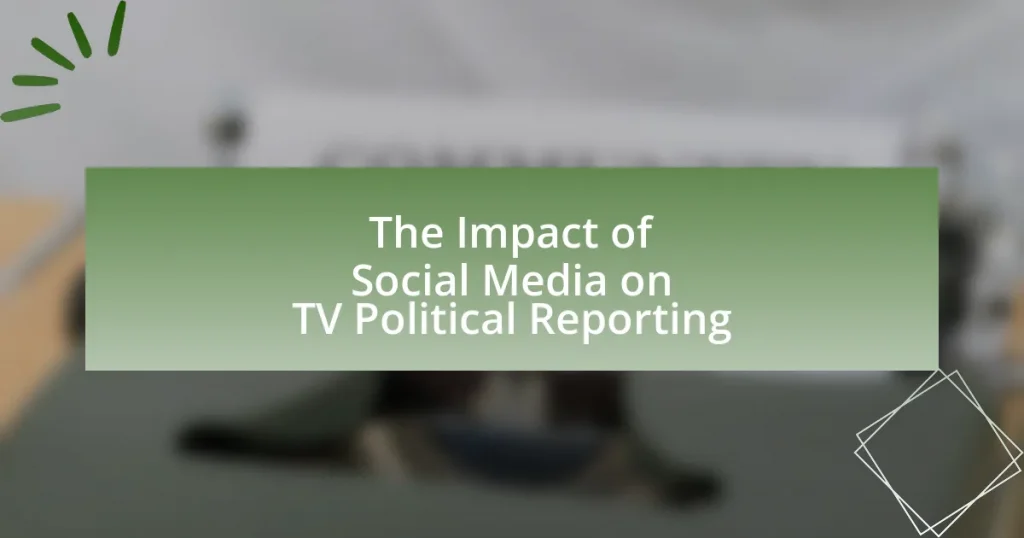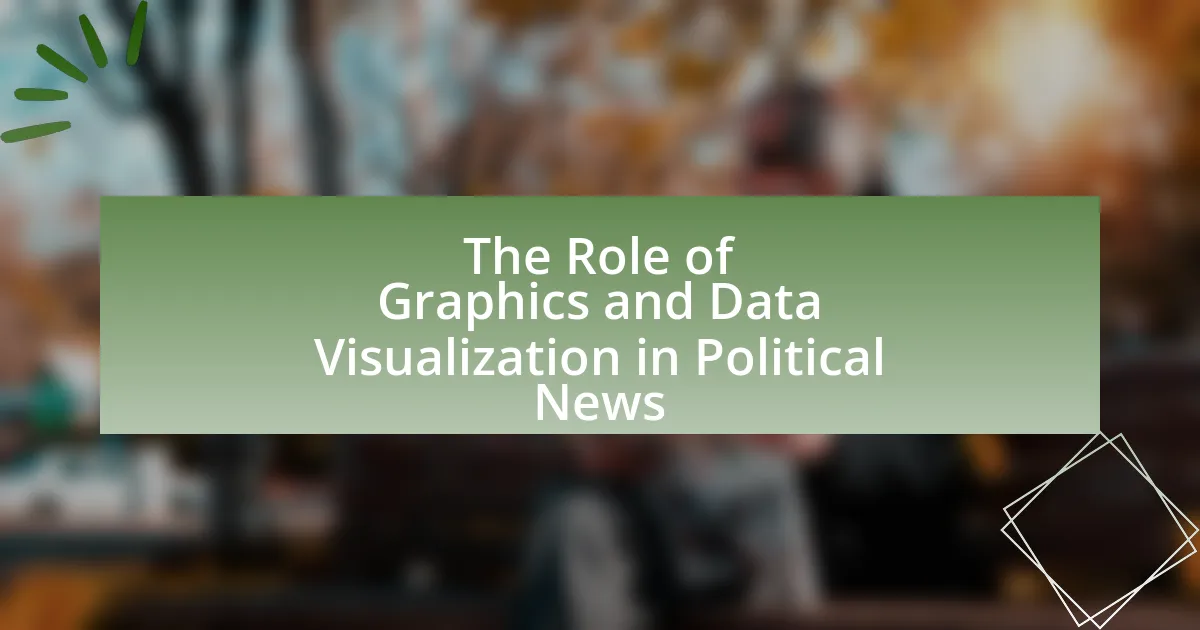The article examines the significant impact of social media on TV political reporting, highlighting how platforms like Twitter and Facebook have transformed news gathering, presentation, and audience engagement. It discusses the shift from traditional media to social media, emphasizing the real-time dissemination of information and the interactive relationship between news outlets and viewers. Key differences between traditional and social media reporting are outlined, along with the challenges faced by TV reporters, such as the spread of misinformation and the pressure for speed over accuracy. The article also explores how audience engagement and social media trends influence content and reporting strategies, as well as the implications for the future of political journalism.
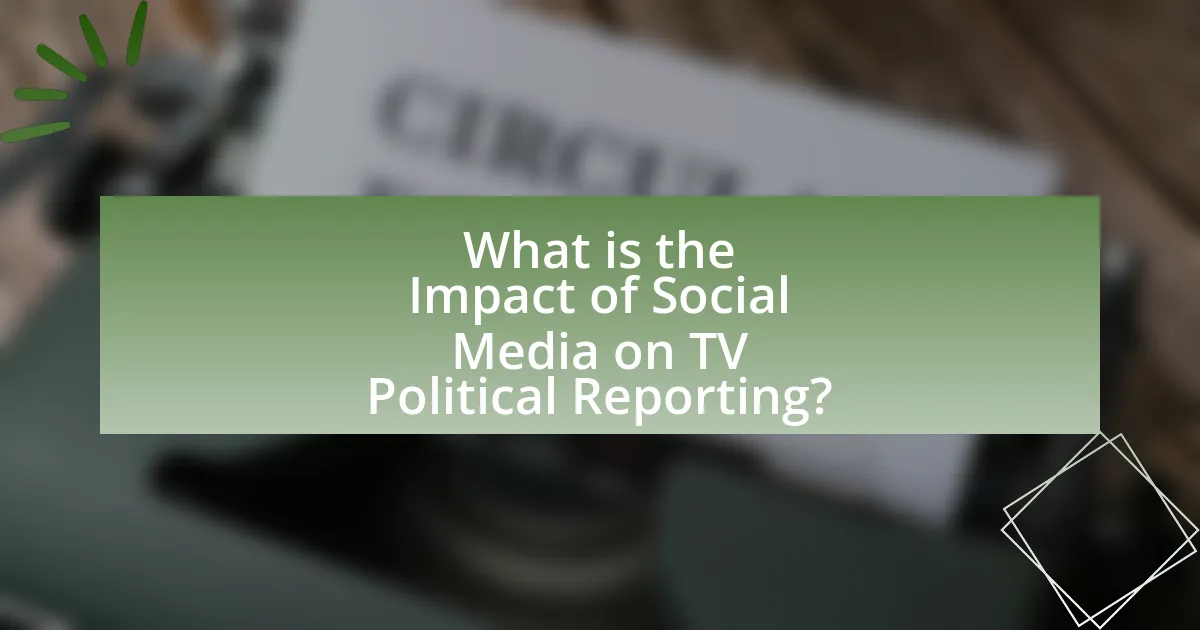
What is the Impact of Social Media on TV Political Reporting?
The impact of social media on TV political reporting is significant, as it alters how news is gathered, presented, and consumed. Social media platforms enable real-time dissemination of information, allowing TV networks to quickly respond to breaking news and public sentiment. For instance, during the 2016 U.S. presidential election, Twitter was used extensively by candidates and journalists alike, influencing the narrative and shaping public discourse. Research by the Pew Research Center indicates that 62% of Americans get news from social media, highlighting its role in shaping political reporting. This shift has led to a more interactive relationship between audiences and news outlets, where viewer engagement can directly influence coverage and editorial decisions.
How has social media changed the landscape of political reporting on TV?
Social media has significantly transformed the landscape of political reporting on TV by enabling real-time news dissemination and audience engagement. Traditional TV news outlets now rely on social media platforms to gather information quickly, allowing them to report breaking news as it unfolds. For instance, during the 2016 U.S. presidential election, platforms like Twitter and Facebook became primary sources for news updates, with many viewers turning to these channels for immediate information rather than waiting for scheduled broadcasts. This shift has led to a more interactive relationship between news organizations and their audiences, as viewers can comment, share, and react to news stories instantly, influencing the narrative and coverage priorities of TV news.
What are the key differences between traditional and social media reporting?
Traditional media reporting relies on established formats such as newspapers, television, and radio, while social media reporting utilizes platforms like Twitter, Facebook, and Instagram for real-time updates. Traditional media typically follows a structured editorial process, ensuring fact-checking and editorial oversight, whereas social media allows for immediate dissemination of information, often prioritizing speed over accuracy. According to a Pew Research Center study, 62% of adults in the U.S. get news from social media, highlighting its growing influence compared to traditional outlets. Additionally, traditional media often has a wider reach and credibility due to established reputations, while social media can amplify misinformation rapidly due to its open nature.
How do social media platforms influence the content aired on TV?
Social media platforms significantly influence the content aired on TV by shaping audience preferences and driving real-time engagement. Television networks monitor trending topics and viewer interactions on platforms like Twitter and Facebook to tailor their programming, ensuring it aligns with public interest. For instance, a study by the Pew Research Center found that 64% of Americans believe social media has a major impact on how news is reported, indicating that networks often adjust their content based on social media feedback and trending discussions. This dynamic creates a feedback loop where social media not only reflects public sentiment but also actively shapes the narratives presented on television.
Why is the relationship between social media and TV political reporting significant?
The relationship between social media and TV political reporting is significant because it shapes public discourse and influences political narratives. Social media platforms allow for real-time dissemination of information, enabling audiences to engage with political content more interactively than traditional TV reporting. According to a Pew Research Center study, 62% of adults in the U.S. get news from social media, highlighting its role in shaping perceptions and discussions around political issues. This interaction can lead to a more informed electorate but also risks the spread of misinformation, which can distort political reporting on TV.
What role does audience engagement play in this relationship?
Audience engagement significantly enhances the relationship between social media and TV political reporting by fostering real-time interaction and feedback. This engagement allows news outlets to gauge public sentiment, adapt their content accordingly, and create a more participatory news environment. For instance, studies indicate that 64% of journalists use social media to understand audience preferences, which directly influences their reporting strategies. Thus, audience engagement not only shapes the content but also strengthens the connection between media producers and consumers, making political reporting more relevant and responsive.
How does social media shape public perception of political events covered on TV?
Social media significantly shapes public perception of political events covered on TV by providing real-time commentary and diverse viewpoints that influence audience interpretation. For instance, platforms like Twitter and Facebook allow users to share opinions and reactions immediately after televised political events, creating a dialogue that can amplify certain narratives or frame issues in specific ways. Research by the Pew Research Center indicates that 62% of adults in the U.S. get news from social media, highlighting its role in shaping perceptions. This interaction can lead to a more polarized understanding of events, as users often engage with content that aligns with their pre-existing beliefs, thereby reinforcing those views and affecting how televised coverage is received.
What challenges do TV political reporters face due to social media?
TV political reporters face significant challenges due to social media, including the rapid spread of misinformation. This misinformation can undermine the credibility of traditional news outlets, as audiences may trust social media sources over established journalism. Additionally, the pressure to produce content quickly for social media platforms can lead to less thorough fact-checking, resulting in the dissemination of inaccurate information. According to a 2020 Pew Research Center study, 53% of U.S. adults say they often encounter made-up news, which complicates the reporting landscape for journalists who strive for accuracy. Furthermore, the constant scrutiny and criticism from social media users can create a hostile environment, impacting reporters’ mental health and their ability to perform their duties effectively.
How does the speed of social media affect the accuracy of TV reporting?
The speed of social media significantly impacts the accuracy of TV reporting by creating pressure to deliver news quickly, often leading to the dissemination of unverified information. As social media platforms enable real-time sharing of information, TV news outlets may prioritize speed over thorough fact-checking, resulting in potential inaccuracies. For instance, during breaking news events, such as the Boston Marathon bombing in 2013, initial reports on social media often contained incorrect details that were later propagated by TV networks, illustrating how the rush to report can compromise accuracy. This phenomenon highlights the challenge faced by traditional media in maintaining journalistic standards while competing with the immediacy of social media.
What are the implications of misinformation spread through social media for TV news?
Misinformation spread through social media significantly undermines the credibility and trustworthiness of TV news. As audiences increasingly rely on social media for information, they may encounter false narratives that conflict with factual reporting from traditional news outlets. This discrepancy can lead to viewer skepticism towards TV news, as studies indicate that 64% of Americans believe that misinformation on social media has a negative impact on their understanding of current events. Consequently, TV news organizations face pressure to fact-check and verify information more rigorously, which can strain resources and affect reporting speed. Additionally, the rapid dissemination of misinformation can create a challenging environment for journalists, who must navigate public perceptions shaped by misleading social media content.
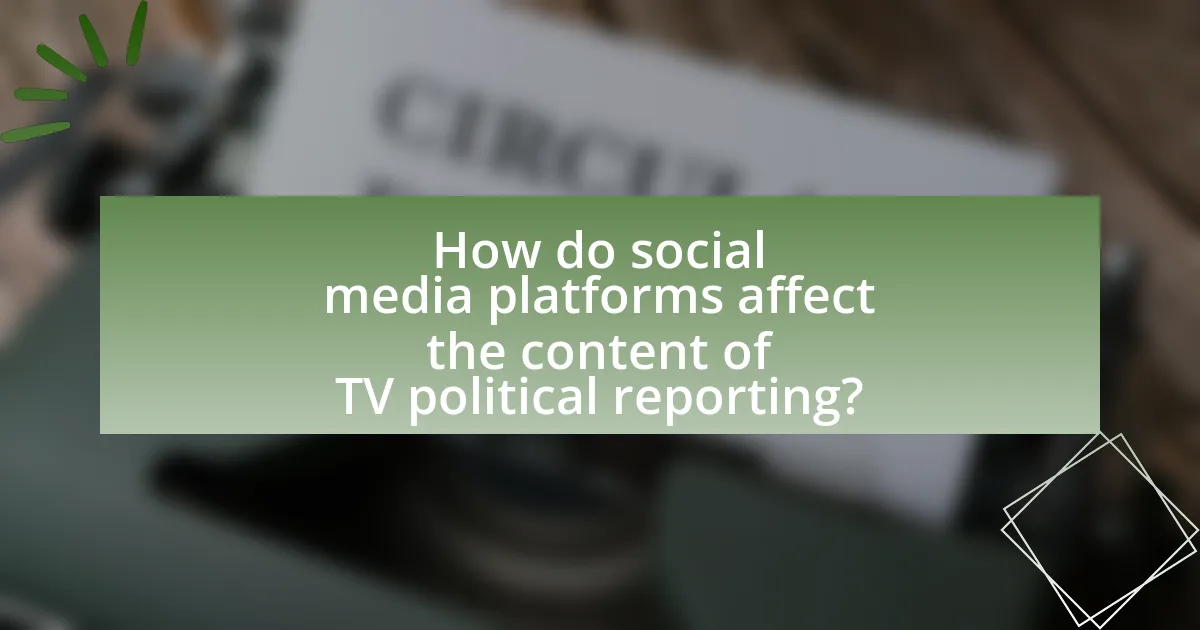
How do social media platforms affect the content of TV political reporting?
Social media platforms significantly influence the content of TV political reporting by shaping the narratives and topics that are prioritized in news coverage. The immediacy and interactivity of social media allow for real-time feedback and audience engagement, which can lead TV networks to adjust their reporting to align with trending discussions and public sentiment. For instance, a study by the Pew Research Center found that 62% of adults in the U.S. get news from social media, indicating that platforms like Twitter and Facebook serve as critical sources for news stories that TV networks may choose to cover. Additionally, social media can amplify certain voices and perspectives, leading to a more diverse range of topics being reported on television, as seen during events like the Black Lives Matter protests, where social media drove coverage of issues that may have been overlooked in traditional reporting.
What types of content are most influenced by social media trends?
Content types most influenced by social media trends include news articles, video content, memes, and user-generated content. News articles often adapt to trending topics on social media to capture audience attention, as seen with major news outlets rapidly reporting on viral events. Video content, particularly short-form videos on platforms like TikTok and Instagram, reflects current trends and engages viewers through relatable themes. Memes leverage social commentary and humor, often going viral and influencing public discourse. User-generated content, such as posts and comments, shapes narratives and public opinion, demonstrating the interactive nature of social media in political reporting.
How do viral social media posts impact TV news coverage?
Viral social media posts significantly influence TV news coverage by shaping the topics that news outlets prioritize and report on. When a post gains traction, it often prompts news organizations to cover the story to attract viewers and remain relevant. For instance, a study by the Pew Research Center found that 62% of adults in the U.S. get news from social media, indicating that viral content can dictate the news agenda. Additionally, TV news often incorporates viral posts into their segments, using them as visual aids or sources of public sentiment, which further amplifies the reach and impact of the original social media content.
What are the effects of user-generated content on TV political reporting?
User-generated content significantly influences TV political reporting by enhancing audience engagement and diversifying perspectives. This content allows viewers to contribute their opinions and experiences, which can lead to a more comprehensive understanding of political issues. For instance, during the 2016 U.S. presidential election, platforms like Twitter and Facebook enabled users to share real-time reactions and insights, which TV networks incorporated into their coverage, thereby reflecting a broader range of public sentiment. Research indicates that 62% of journalists reported using social media to gather information and source stories, demonstrating the integration of user-generated content into traditional reporting practices.
How do TV networks adapt their reporting strategies in response to social media?
TV networks adapt their reporting strategies in response to social media by integrating real-time audience engagement and utilizing social media analytics to shape content. This adaptation includes monitoring trending topics on platforms like Twitter and Facebook to inform news coverage, ensuring that the content resonates with viewers’ interests. For instance, a study by the Pew Research Center found that 62% of adults get news from social media, prompting networks to prioritize stories that are gaining traction online. Additionally, networks often incorporate user-generated content and live social media feeds into broadcasts, enhancing viewer interaction and relevance. This shift reflects a broader trend where traditional media aligns its strategies with the immediacy and interactivity of social media platforms.
What new formats or segments have emerged due to social media influence?
New formats and segments that have emerged due to social media influence include live streaming, short-form video content, and interactive polls. Live streaming allows real-time engagement with audiences, exemplified by platforms like Facebook Live and Instagram Live, where political figures can address constituents directly. Short-form video content, popularized by TikTok and Instagram Reels, enables quick dissemination of political messages and campaign highlights, appealing to younger demographics. Interactive polls on platforms like Twitter and Instagram Stories facilitate immediate feedback and engagement, allowing political reporting to adapt to audience preferences and opinions. These formats reflect a shift towards more dynamic and participatory political communication, driven by the immediacy and accessibility of social media.
How do TV networks measure the impact of social media on their political reporting?
TV networks measure the impact of social media on their political reporting primarily through analytics tools that track engagement metrics such as likes, shares, comments, and overall reach. These metrics provide quantitative data on how audiences interact with political content shared on platforms like Twitter and Facebook, allowing networks to assess the effectiveness of their reporting. For instance, a study by the Pew Research Center found that 62% of adults get news from social media, highlighting its significant role in shaping public discourse. By analyzing these interactions, networks can adjust their strategies to better align with audience preferences and enhance their political coverage.
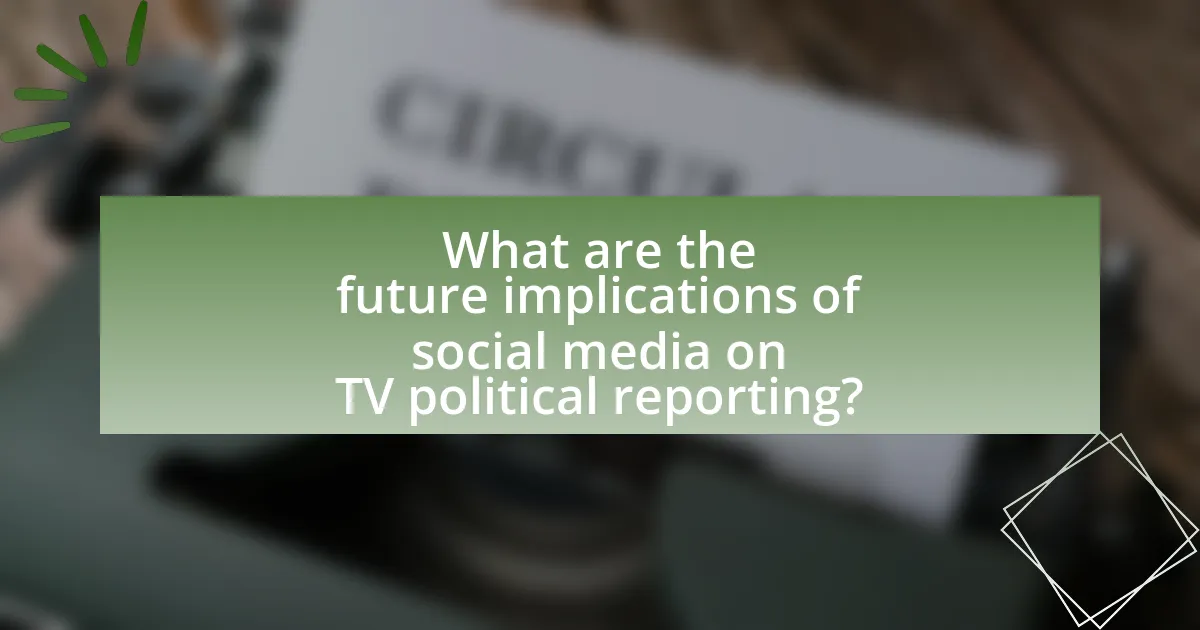
What are the future implications of social media on TV political reporting?
Social media will increasingly shape TV political reporting by enhancing real-time audience engagement and influencing news narratives. As platforms like Twitter and Facebook allow for immediate feedback and interaction, TV networks will likely adapt their reporting strategies to incorporate audience reactions and trending topics, leading to a more dynamic and responsive news cycle. For instance, a Pew Research Center study indicates that 62% of Americans get news from social media, highlighting its growing role in shaping public discourse and media coverage. This shift may result in a greater emphasis on sensationalism and clickbait to capture viewer attention, potentially compromising journalistic integrity.
How might the relationship between social media and TV evolve in the coming years?
The relationship between social media and TV is likely to evolve towards greater integration and interactivity in the coming years. As audiences increasingly consume content across multiple platforms, TV networks will likely adopt social media strategies to engage viewers in real-time discussions and feedback during broadcasts. For instance, a study by the Pew Research Center in 2021 found that 53% of adults in the U.S. reported using social media to follow news, indicating a shift in how audiences interact with news content. This trend suggests that TV networks may incorporate social media feeds into their programming, allowing for live audience participation and enhancing viewer engagement. Additionally, the rise of streaming services and on-demand content is pushing traditional TV to adapt by leveraging social media for promotional purposes and audience analytics, further solidifying the interconnectedness of these platforms.
What technological advancements could further change this dynamic?
Artificial intelligence (AI) and machine learning technologies could further change the dynamic of social media’s impact on TV political reporting. These advancements enable real-time data analysis, allowing news organizations to tailor content to audience preferences and enhance engagement. For instance, AI algorithms can analyze social media trends and sentiment, providing insights that inform TV reporting and potentially shift editorial focus. According to a 2021 study by the Pew Research Center, 53% of journalists reported using social media analytics to guide their reporting decisions, highlighting the growing reliance on technology in shaping news narratives.
How can TV political reporters prepare for future challenges posed by social media?
TV political reporters can prepare for future challenges posed by social media by enhancing their digital literacy and developing strategies for fact-checking and audience engagement. As social media platforms increasingly influence public opinion and the dissemination of information, reporters must be adept at navigating these channels to verify facts and counter misinformation. Research indicates that 64% of Americans believe social media is a major source of misinformation, highlighting the need for reporters to implement rigorous verification processes and utilize tools designed for fact-checking. Additionally, engaging with audiences through social media can foster trust and transparency, allowing reporters to address concerns and clarify information directly.
What best practices can TV political reporters adopt in the age of social media?
TV political reporters can adopt best practices such as verifying information before reporting, engaging with audiences through social media platforms, and maintaining transparency about sources. Verifying information is crucial as misinformation can spread rapidly on social media; a study by the Pew Research Center found that 64% of Americans believe that fake news causes confusion about the basic facts of current events. Engaging with audiences allows reporters to build trust and foster dialogue, which is essential in a polarized political climate. Transparency about sources enhances credibility, as audiences are more likely to trust reporters who openly share their information-gathering processes.
How can reporters effectively verify information sourced from social media?
Reporters can effectively verify information sourced from social media by cross-referencing the claims with credible sources and utilizing fact-checking tools. This process involves checking the original context of the information, confirming the identity of the source, and looking for corroboration from multiple reputable outlets. For instance, the Poynter Institute emphasizes the importance of verifying images and videos through reverse image searches and metadata analysis to ensure authenticity. Additionally, employing platforms like Snopes or FactCheck.org can provide reliable verification of claims circulating on social media.
What strategies can enhance audience trust in TV political reporting amidst social media influence?
To enhance audience trust in TV political reporting amidst social media influence, media organizations should prioritize transparency, fact-checking, and audience engagement. Transparency involves clearly disclosing sources and methodologies used in reporting, which builds credibility. Fact-checking is essential; studies show that accurate reporting increases trust, as seen in initiatives like PolitiFact, which verify claims made by public figures. Additionally, engaging with the audience through social media platforms allows for real-time feedback and fosters a sense of community, making viewers feel more connected to the reporting process. This combination of transparency, rigorous fact-checking, and active audience engagement can significantly bolster trust in TV political reporting.
